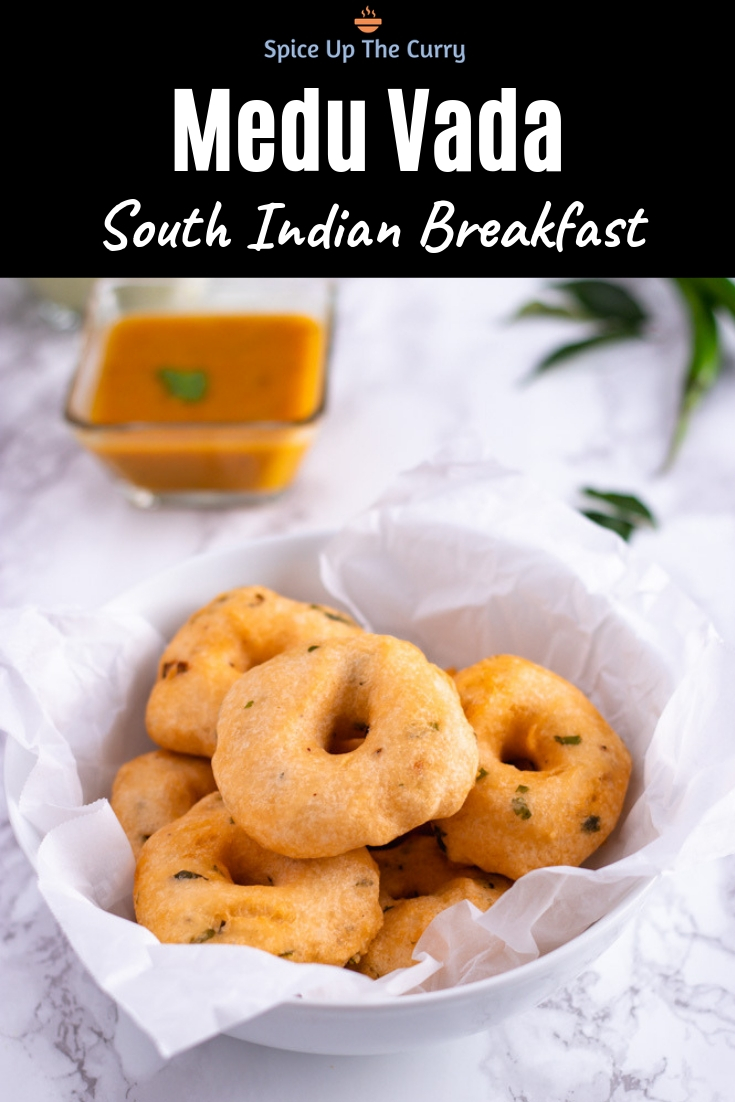The BEST and only medu vada recipe you will ever need!! These turn out crispy from the outside yet soft, fluffy from the inside and perfect every time. Plus, they are very easy to prepare. Here you will learn all the tips and tricks to shaping and perfecting them.
This recipe will give you the perfect, Udupi or south Indian restaurant style medu vada.
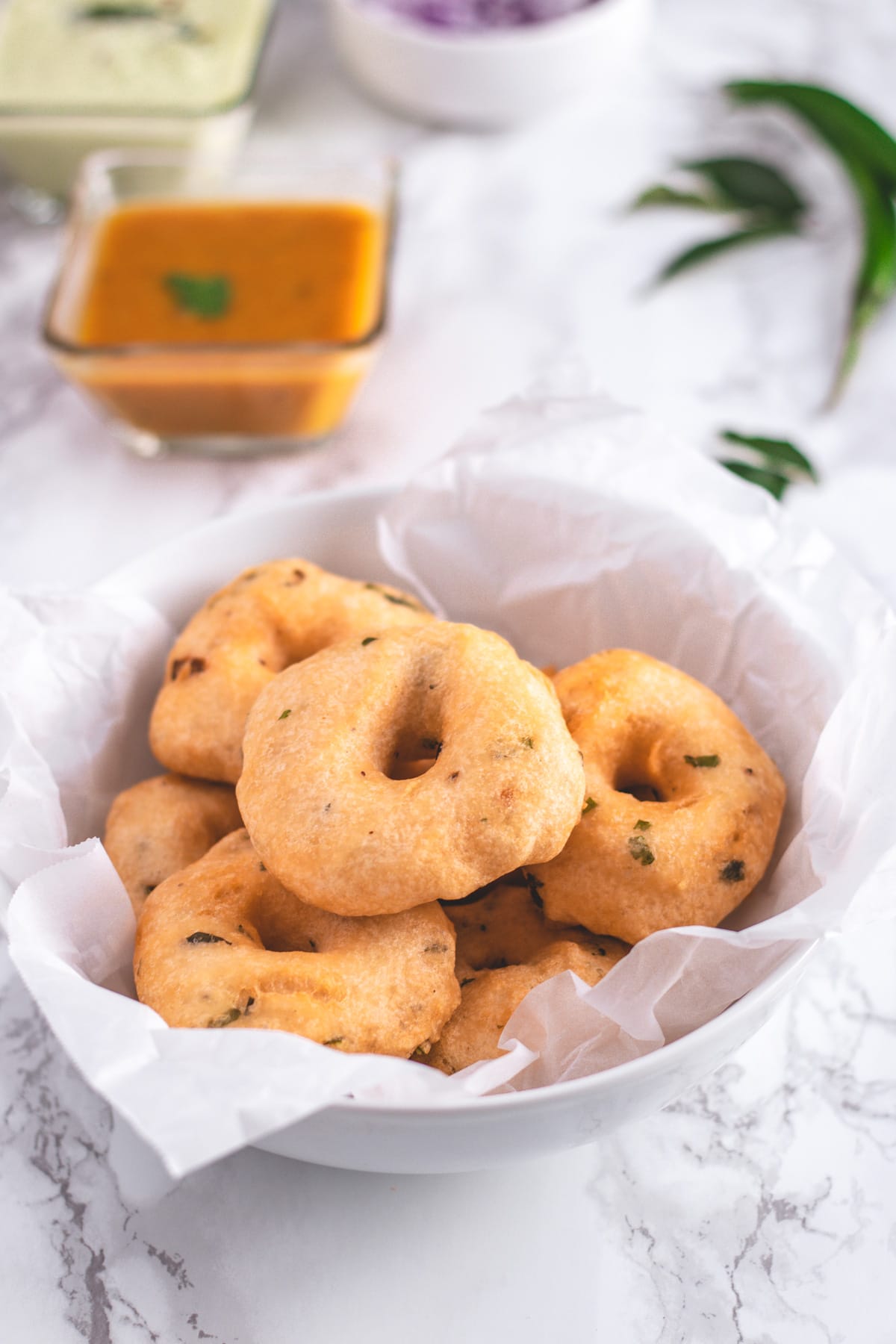
❤️ About This Medu Vada Recipe
Medu vada is the South Indian breakfast made from skinless black lentils (urad dal). The lentil batter is shaped like doughnuts (hole in the center) and deep-fried into the oil. Here medu=soft in Kannada and vada=fritters.
Different regions of India have different names e.g. uddina vade, medhu vadai, ulundu vadai, garelu, uzhunnu vada but the procedure is almost the same.
The traditional South Indian breakfast, medu vada is usually served with coconut chutney (or any other chutneys e.g. tomato chutney, red coconut chutney) and sambar.
Using this vada, you can make sambar vada and rasam vada. (recipes mentioned below)
🧾 Ingredient Notes
Traditional medu vada is made with just 3 ingredients only, urad dal, salt and water. This is how it is made in temples or most households as a neivedyam.
But here I have flavored them with green chilies, cilantro, curry leaves. Some add ginger, chopped onion, black pepper, etc.
- Whole urad dal: For this recipe, you’ll need skinless ones, not the black lentils that you use for dal makhani. Instead, you can use split urad dal as well.
- Rice flour: A little amount is added just to make the outer layer slightly crispy.l
👩🍳 How To Make Medu Vada? (Pics)
Making Batter:
1) Wash the whole skinless urad dal under running cold water until water runs clear. Or rinse the lentils 3-4 times until the water is not cloudy anymore. Then soak in enough water for at least 4 hours. More soaking hours won’t hurt. This is how it looks after the soaking time, they get bigger in size.
2) Then drain all the water and take it into the grinder jar. Start by adding little water and increase the amount as needed. Grind into the smooth batter. I used a total of 6 tablespoons of water. The batter consistency should be medium (not too thick, not too thin and runny).
3) While the grinding process, you may need to stop and scrape the sides and continue grinding.
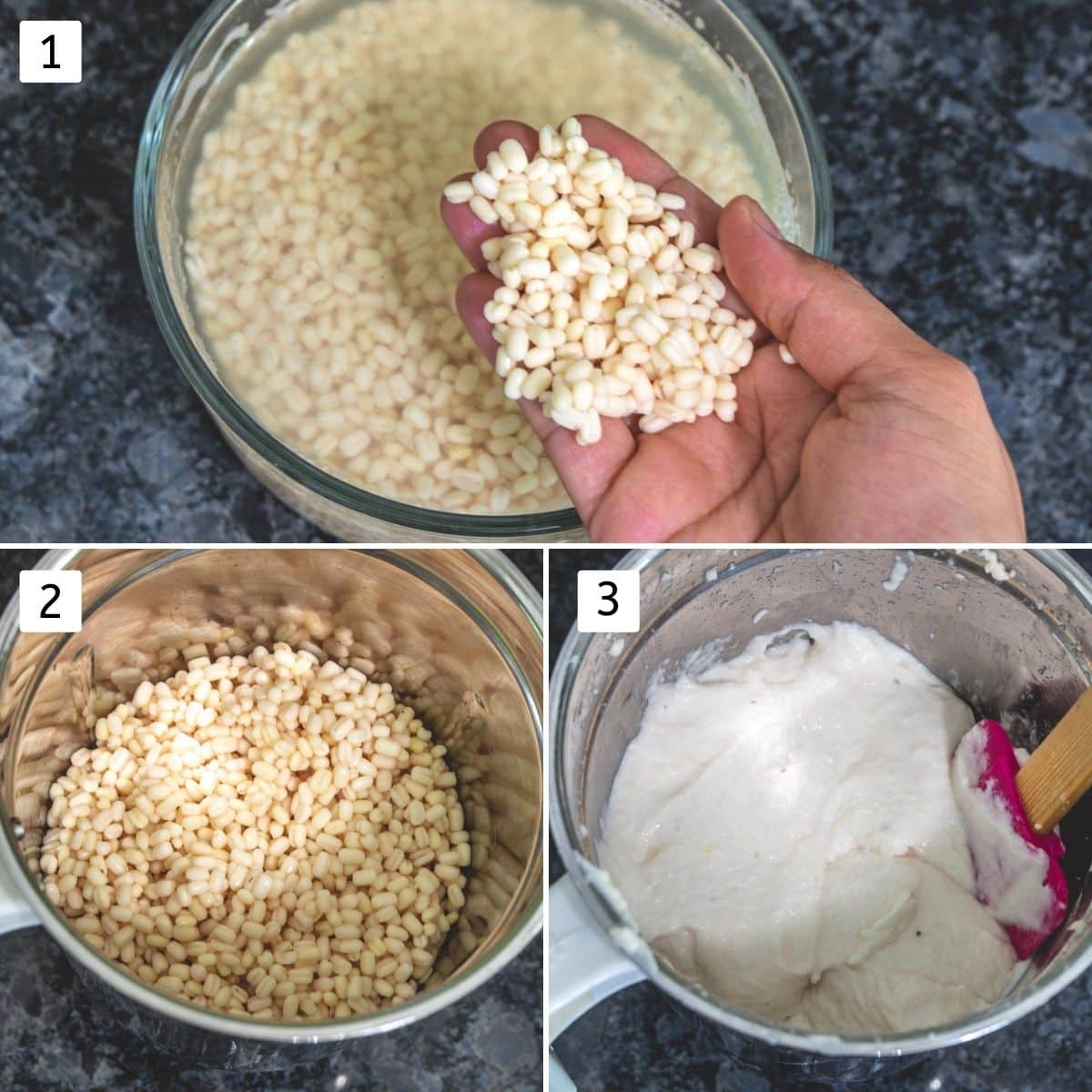
4) Remove it to a large bowl. Add salt, green chilies, cilantro, and curry leaves.
5) Mix and also add rice flour.
6) Mix well and beat it (stir vigorously) for about 3-4 minutes to make the fluffy batter. Do the beating step by hand or use the stand mixer with a whisk attachment.
7) Check the right consistency batter: drop a little amount of batter in a bowl of water. It should float on top, meaning the batter has a perfect consistency and is fluffy. If it sinks at the bottom means the batter is heavy, it needs more whipping to make it light and fluffy.
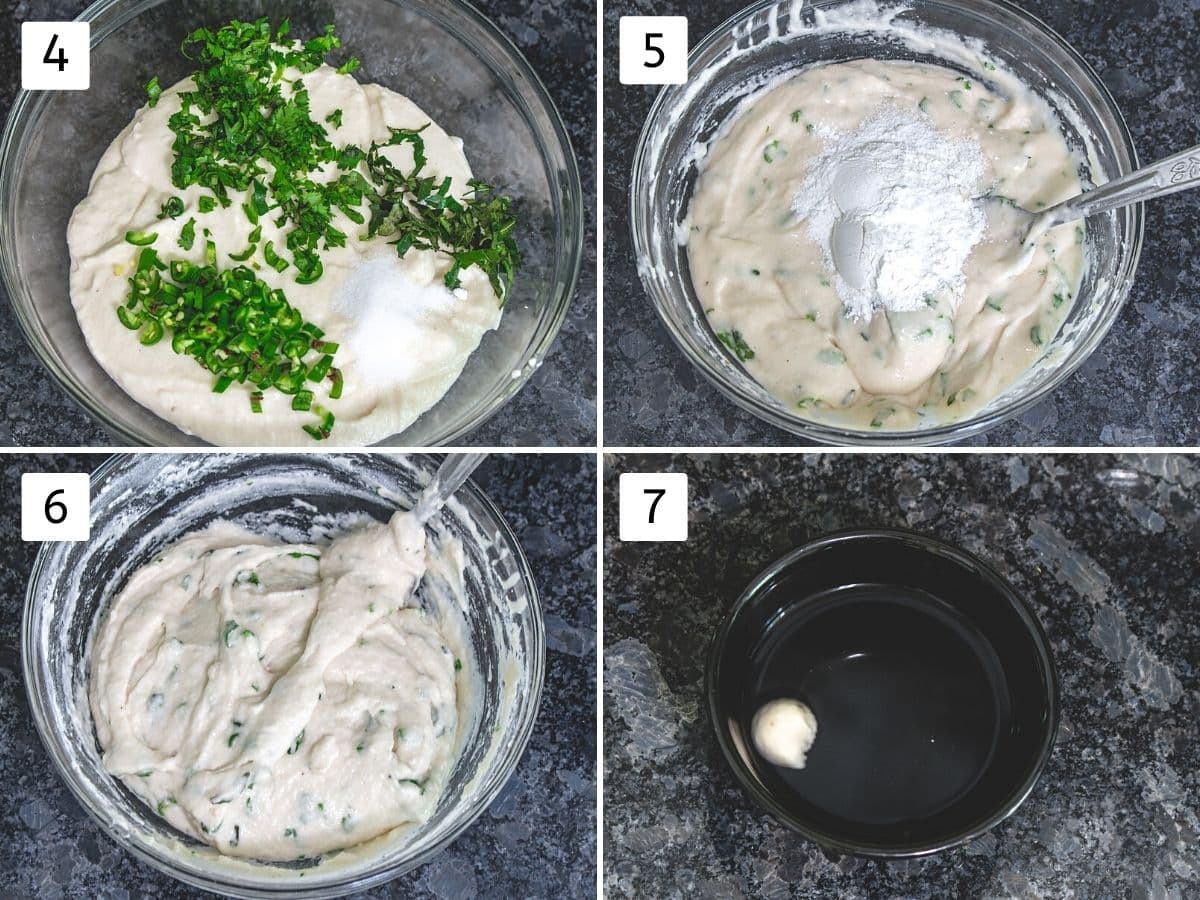
Shaping & Frying:
8) Heat the oil in a pan on medium heat for frying vadas. To shape the vada, keep the bowl of water handy. Dip your hand generously into the water.
9) Take a large spoonful of batter on the wet hand (not on the palm, on your four fingers), then make a hole in the center using your thumb (make sure your thumb is wet as well, so the batter doesn’t stick to your fingers).
10) You can see the donut-shaped medu vada.
11) Slide the shaped vada carefully into the hot oil (because of the water, it will easily slide off from your hand). Repeat the same and fry the vada in batches. Do flip them while frying for even browning.
12) Once golden brown and crispy from both sides, then remove them using a slotted spatula and place it on a paper towel lined plate.
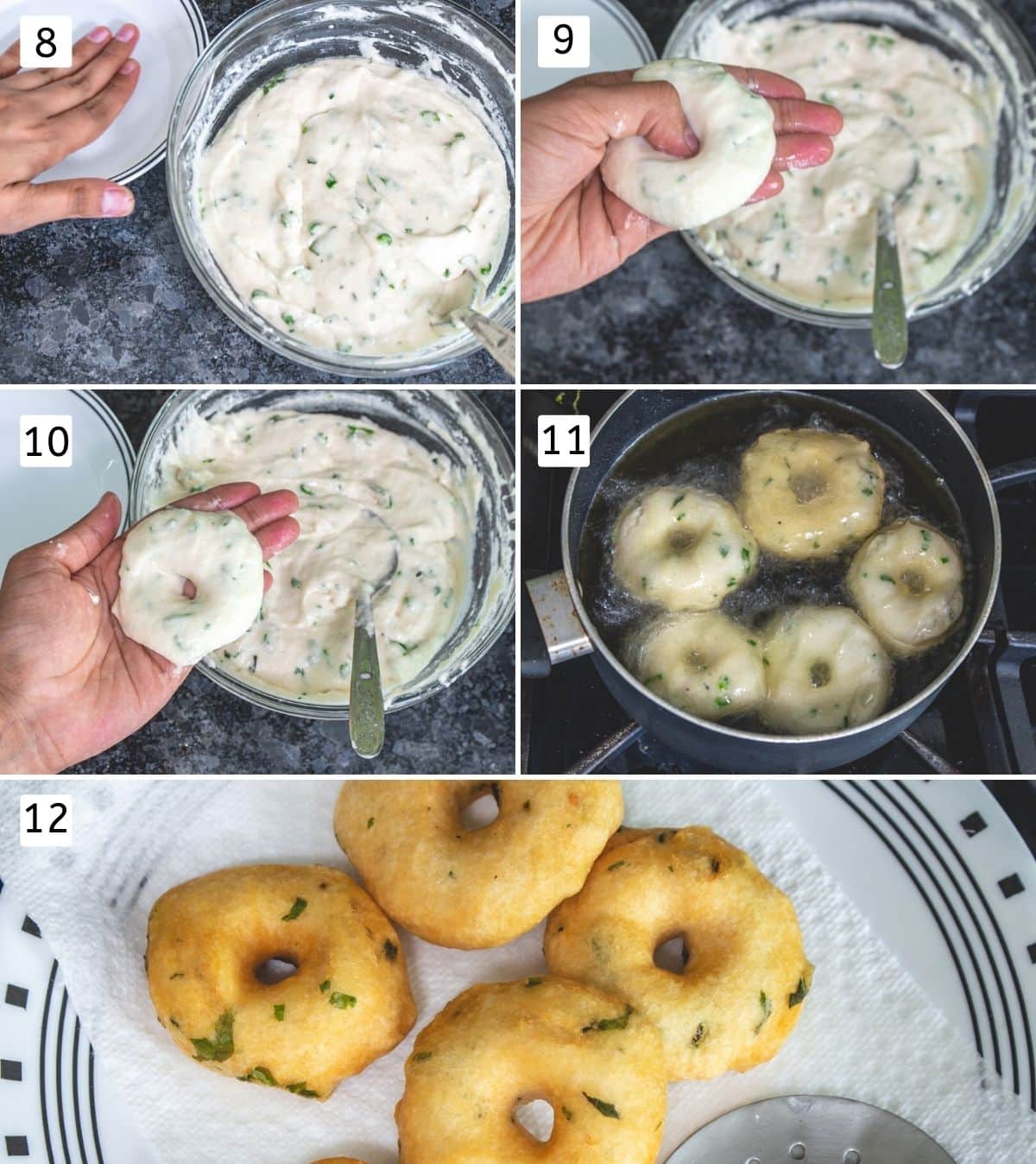
How To Make Sambar Vada?
- To make sambar vada, take a bowlful of sambar in a pan and thin it out by adding some water. Heat it till it just starts boiling. Dip the vada in thinned-out sambar and soak for around 1-2 hours. Vada will absorb the sambar and will become soft.
- At the time of serving, place the vada on an individual serving plate, and pour more sambar (regular consistency) on top.
- Garnish with finely chopped onions and serve. If you like, you can drizzle some coconut chutney on top as well.
- Similarly, you can make rasam vada (use rasam instead of sambar). But in this case, no need to thin out using water because rasam is already thin in consistency.
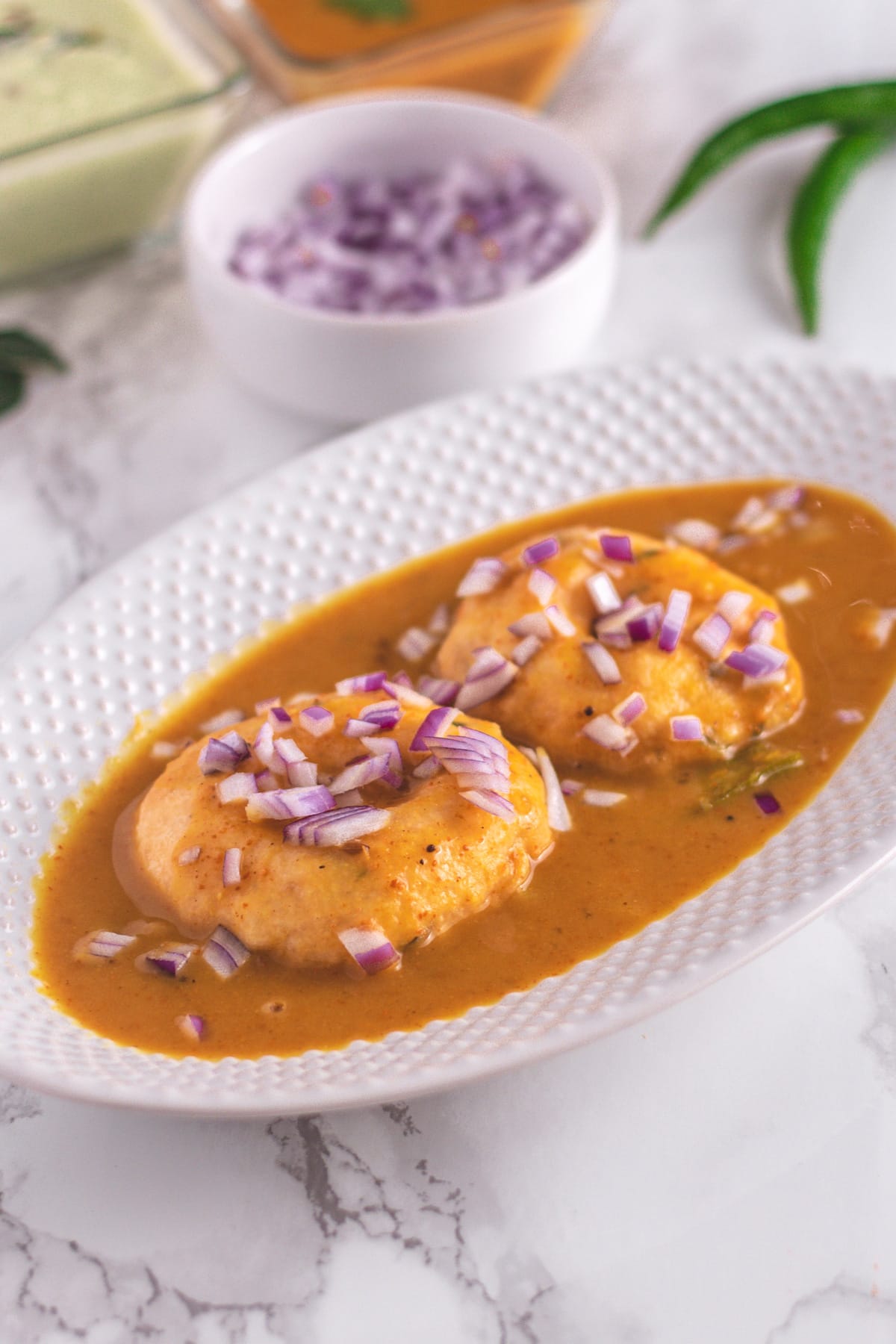
💭 Tips To Make Soft Medu Vada
- Soak the lentils for at least 4 hours or more the better.
- Grind the batter to smooth consistency (not coarse).
- The batter must be beaten/whipped to aerate until it is light and fluffy.
- The batter consistency has to be right (not too thin, not too thick). So do not add too much water in the beginning while grinding. Start with a little and add more as needed.
- If the batter becomes thin and runny by mistake, then add some more rice flour or ground poha.
💭 Medu Vada Shaping Tips
- To avoid sticking batter to your hand, wet your hand really well. Always keep in mind that urad dal is shy of water, so it will easily slide from your wet hand without sticking.
- If shaping the vada is difficult for you then just drop the spoonful of batter in hot oil to make simple round vada just like dahi vada.
- Instead of shaping it on hand, you can shape it on a plastic sheet or directly on the spatula and transfer it to the hot oil.
- Medu vada maker is available in the market. Does it work? I don’t know, I have never tried. If you have tried, let me know in the comments.
💭 Medu Vada Frying Tips:
- To make vada less oily, make sure that the oil is hot enough at the right temperature. If the oil is not hot enough then vada will soak up too much oil.
- Also, if the oil is not hot enough then vada becomes hard and chewy.
- If the oil is too hot then vada will get brown quickly from the outside and stays raw from the inside.
🥣 Storage Instructions
- The medu vada batter can be stored in the refrigerator for a day or two.
- The fried medu vada can be stored in the refrigerator in an airtight container for 2-3 days. Reheat in the microwave though refrigerated vada will lose its crispness. These leftover vadas are perfect for sambar vada or rasam vada.
- Freeze the fried vada and use them within 2-3 months.
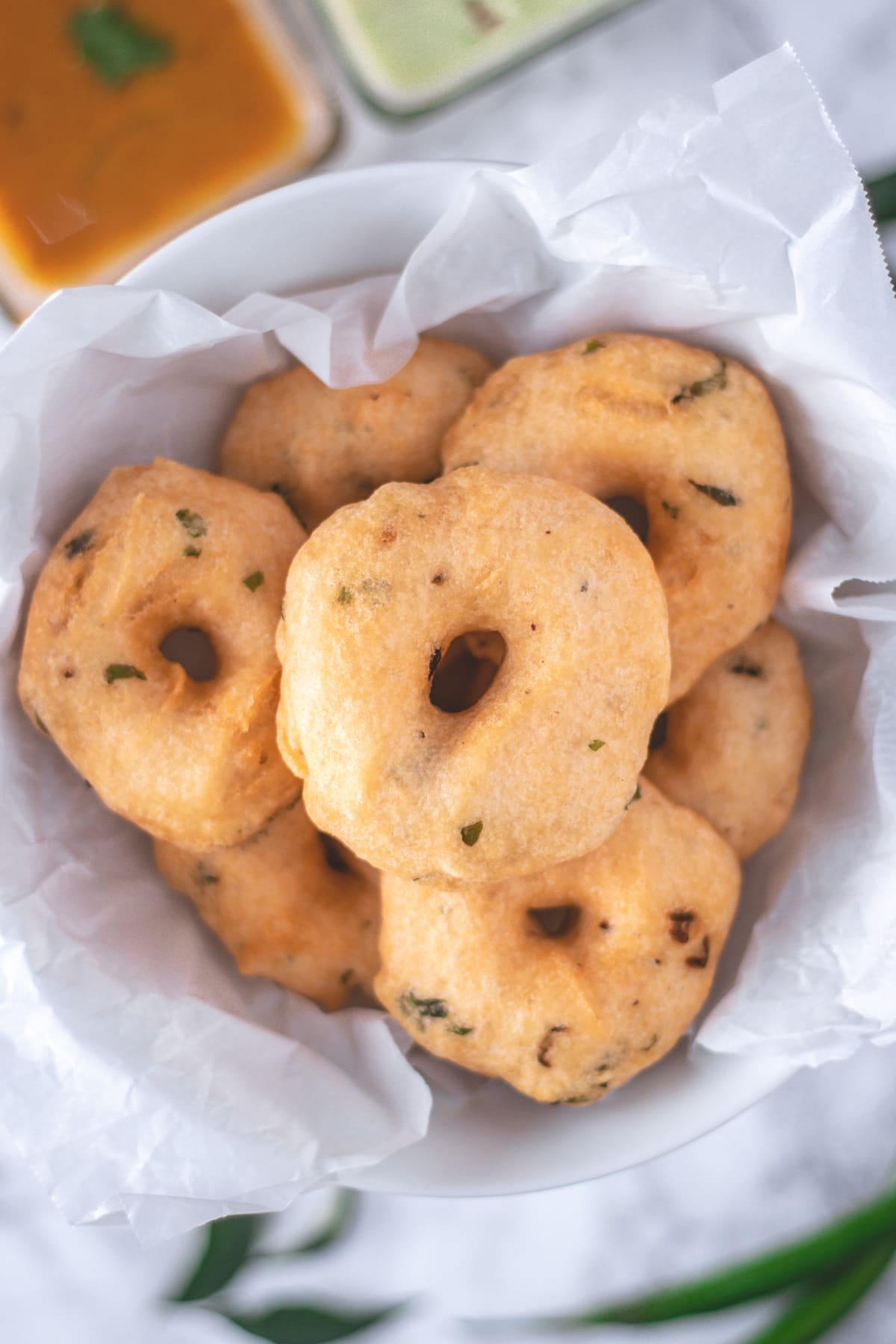
Did you try this medu vada recipe? I’d love to hear about it! Click here to leave a review.
Medu Vada Recipe (Sambar Vada)
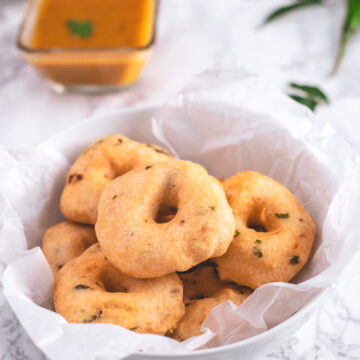
Medu vada is the traditional South Indian breakfast which is made from whole urad dal. These vada are soft from inside and crispy from outside. It is served with coconut chutney and sambar.
US measuring cups are used (1 cup = 240 ml)
- 1 cup Whole urad dal, (Skinless)
- 6-8 tablespoons Water, (cold) for grinding
- 1 teaspoon Salt, or to taste
- 1 Green chili, finely chopped
- 2 tablespoons Cilantro or coriander leaves
- 6 Curry leaves, finely chopped
- 2 tablespoons Rice flour
- Oil, for deep frying
Prevent your screen from going dark
Making Batter:
-
Wash the whole skinless urad dal under running cold water until water runs clear. Or rinse the lentils 3-4 times until the water is not cloudy anymore. Then soak in enough water for at least 4 hours. More soaking hours won’t hurt. After soaking they get bigger in size.
-
Then drain all the water and take it into the grinder jar. Start by adding little water and increase the amount as needed. Grind into a smooth batter. I used a total of 6 tablespoons of water. The batter consistency should be medium (not too thick, not too thin and runny).
-
While the grinding process, you may need to stop and scrape the sides and continue grinding.
-
Remove it to a large bowl. Add salt, green chilies, cilantro, curry leaves, and rice flour and mix.
-
Beat it (stir vigorously) for about 3-4 minutes to make the fluffy batter. Do the beating step by hand or use the stand mixer with a whisk attachment.
-
Check the right consistency batter: drop a little amount of batter in a bowl of water. It should float on top, meaning the batter has a perfect consistency and is fluffy. If it sinks at the bottom means the batter is heavy, it needs more whipping to make it light and fluffy.
Shaping & Frying:
-
Heat the oil in a pan on medium heat for frying vadas. To shape the vada, keep the bowl of water handy. Dip your hand generously into the water.
-
Take a large spoonful of batter on the wet hand (not on the palm, on your four fingers), then make a hole in the center using your thumb (make sure your thumb is wet as well, so the batter doesn’t stick to your fingers). You can see the donut-shaped medu vada.
-
Slide the shaped vada carefully into the hot oil (because of the water, it will easily slide off from your hand). Repeat the same and fry the vada in batches. Do flip them while frying for even browning.
-
Once golden brown and crispy from both sides, then remove it using a slotted spatula and place it on a paper towel lined plate.
- Soak the lentils for at least 4 hours or more the better.
- Grind the batter to smooth consistency (not coarse).
- The batter must be beaten/whipped to aerate until it is light and fluffy.
- The batter consistency has to be right (not too thin, not too thick). So do not add too much water in the beginning while grinding. Start with a little and add more as needed.
- If the batter becomes thin and runny by mistake, then add some more rice flour or ground poha.
Shaping Medu Vada Tips:
- To avoid sticking batter to your hand, wet your hand really well. Always keep in mind, urad dal is shy of water, so it will easily slide from your wet hand without sticking.
- If shaping the vada is difficult for you then just drop the spoonful of batter in hot oil to make simple round vada just like dahi vada.
- Instead of shaping it on hand, you can shape it on a plastic sheet or directly on the spatula and transfer it to the hot oil.
- Medu vada maker is available in the market. Does it work? I don’t know, I have never tried. If you have tried, let me know in the comments.
Frying Tips:
- To make vada less oily, make sure that the oil is hot enough at the right temperature. If the oil is not hot enough then vada will soak up too much oil.
- Also, if the oil is not hot enough then vada becomes hard and chewy.
- If the oil is too hot then vada will get brown quickly from the outside and stays raw from the inside.
Serving: 2no. | Calories: 204kcal (10%) | Carbohydrates: 13.2g (4%) | Protein: 5.1g (10%) | Fat: 14.8g (23%) | Saturated Fat: 1.9g (10%) | Sodium: 236mg (10%) | Potassium: 186mg (5%) | Fiber: 5.9g (24%) | Sugar: 0.4g
